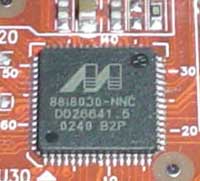
Original Link: https://www.anandtech.com/show/1091
ABIT BH7 (845PE): Entry Level 800MHz FSB
by Evan Lieb on April 6, 2003 6:56 PM EST- Posted in
- Motherboards
We were supposed to end our coverage of Intel's last single channel DDR chipset
(845PE) with our January 13th review of the ABIT IT7 Max2 V.2 motherboard, but since then
a few things have materialized, namely 800MHz FSB compatible 845PE motherboards.
In particular, ABIT's new 800MHz FSB 845PE motherboard (BH7), the successor
to the hugely successful BH6.
We weren't surprised ABIT was planning a successor to the BH6, just excited to hear about it. Though the BH7 won't be nearly as successful as the BH6 was, it has the makings of a stellar motherboard given the features, overclocking options and the selling price.
Read on to learn more about ABIT's latest Pentium 4 motherboard…
ABIT BH7 Version 1.1: Basic Features
|
Motherboard Specifications |
|
|
CPU
Interface
|
Socket-478
|
|
Chipset
|
Intel
82845PE MCH
Intel 82801DB ICH4 |
|
Bus
Speeds
|
up
to 250MHz (in 1MHz increments)
|
|
Core
Voltages Supported
|
up
to 1.95V (in 5% increments)
|
|
I/O
Voltages Supported
|
N/A
|
|
DRAM
Voltages Supported
|
up
to 3.05V (in 0.1V increments)
|
|
Memory
Slots
|
3
184-pin DDR DIMM Slots
|
|
Expansion
Slots
|
1
AGP 4X Slot
5 PCI Slots |
|
Onboard
RAID
|
N/A
|
|
Onboard
USB 2.0/IEEE-1394
|
USB2
Supported through South Bridge
No Firewire Controller |
|
Onboard
LAN
|
Realtek
8101L
|
|
Onboard
Audio
|
Realtek
ALC650 6-channel audio
|
|
Onboard
Serial ATA
|
Marvell
88i8030 controller
|
|
BIOS
Revision Tested
|
03/04/2003
|
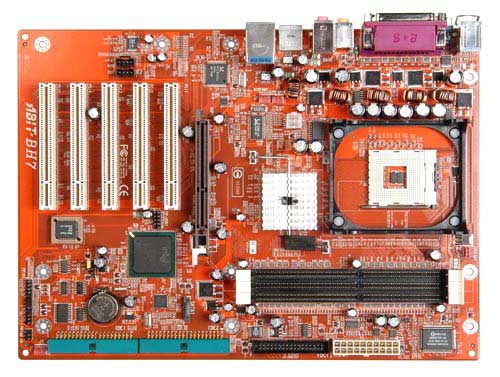
ABIT decided to go with a fairly cheap LAN solution in the form of Realtek's 8101L controller. This fairly basic 10/100 controller should satisfy just about any user looking for a reliable LAN.
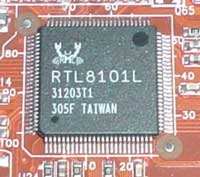 |
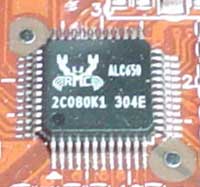 |
ABIT also went with Realtek for the BH7's onboard sound controller. The well-known ALC650 DAC is used in the BH7's case, and is simply a decent 6-channel sound solution for most users. Unfortunately, Realtek nor ABIT includes any user-friendly software for novice users to help in the setup of their sound systems.
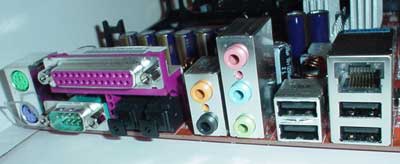
The BH7's I/O configuration features two PS/2 ports, one serial port, one parallel port, four rear USB 2.0 ports, a LAN port, an optical out port, and Mic In, Line In, and Line Out, which drive the onboard sound. This is a nice blend of different serial technologies, especially the optical out port for those users that don't want to use the analog out.
ABIT uses a Marvell 88i8030 Serial ATA controller on the BH7; for a better understanding of Marvell's 88i8030 controller, we've taken a paragraph from Marvell's web site explaining exactly what this controller does:
By converting Parallel ATA (PATA) to Serial ATA (SATA), the Marvell® 88i8030 SATA bridge product allows hard disk drive, PC/server motherboard and storage subsystem manufacturers to use their current PATA electronics for fast time-to-market. The 88i8030 device interfaces to traditional PATA hard disk drive (HDD) controllers as well as to host chipsets running up to 150 Megabytes per second (MBps).
So with the single Serial ATA connector present on the BH7, you will be able to connect one Serial ATA hard drive or one Parallel ATA (EIDE) hard drive to your system. This, of course, excludes the Primary and Secondary IDE channels.
The ICH4 South Bridge, as usual, supports USB 2.0 technology. In total, you're allowed to enable up to six USB 2.0 ports on the BH7; four of those USB 2.0 ports are available in the I/O panel and the final two are available via a USB 2.0 bracket bundled with the ABIT BH7. This is a standard high-end USB package for such an overclocker-friendly motherboard.
Unfortunately no FireWire was included with the ABIT BH7 via onboard headers, rear ports, daughter cards, or any other method of connectivity. However FireWire isn't cheap and the BH7 isn't an all-in-one-wonder of a motherboard (though it is close), it's a value performance motherboard.
ABIT BH7: Board Layout
In general we liked the ABIT laid out their new BH7 motherboard, as most of our criteria for a convenient layout were met.
The ATX (20-pin) connector is located right where we usually like it to be, near the top right-hand corner of the PCB. Positioning the ATX (20-pin) connector in this way can prevent a basic PSU (power supply unit) thick ATX wires from obstructing the installation/uninstallation of the CPU HSF, passive North Bridge heatsink or any other components that you may decide to modify or uninstall in that general area. The ATX (20-pin) connector's position is less important if you own a high quality PSU from, for example, Enermax or Antec because these PSU's always have extra-long ATX cables that can be tucked away from obstructing motherboard components.
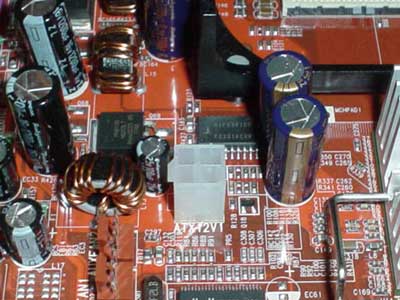
The ATX12V connector is located a bit too closely to the lower left-hand portion of the CPU clamps and therefore will cause a bit of an annoyance if you want to install/uninstall a CPU heatsink. What makes this an annoyance isn't just the ATX12V connector's position but the fact that a tiny capacitor sits right next to the ATX12V's clamp, requiring either a tool or tiny fingers to unhinge the ATX12V line.
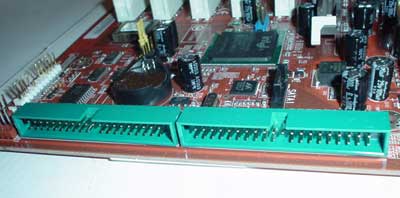
The Primary and Secondary IDE connectors are placed very awkwardly on the BH7. For some reason they're both placed horizontally and at the edge of the PCB. This is awkward because you have to twist your IDE cables while colluding with a long video card to get them to the upper bays of an ATX case for connection to an optical drive. If ABIT had included rounded IDE cables this might not be an issue, but since they didn't it is something worth noting. We usually like to see the Primary and Secondary IDE connectors higher up on the right-hand portion of the PCB so that IDE cable length and clutter doesn't become an issue. On the whole however, it's certainly not the worst Primary/Secondary IDE connector location we've seen.
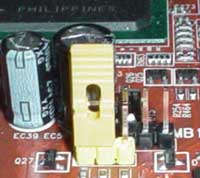
It's well known that most ABIT motherboards cater to enthusiasts/experts of the hardware world. This is illustrated in a tiny way with their CMOS jumper, which has been elongated more than normal. This is helpful in that people of any size fingers can reset the CMOS jumper without issue, as isn't always the case with CMOS jumper sizes. For overclockers this is especially useful, as clearing the CMOS can become a common activity for them.
Thankfully the DIMM connectors aren't located too close to the ASUS GeForce4 Ti4600 video card we installed. The DIMM connectors are far enough away from the AGP slot so that you can stick your finger in between them; this allows the user enough room to install/uninstall memory without being forced to uninstall the video card, VGA screw, and VGA adapter.
ABIT BH7: BIOS and Overclocking
ABIT's famous Soft Menu III BIOS is utilized yet again, this time with the BH7. We've always enjoyed tweaking within Soft Menu III, and the BH7's BIOS setup was no different (if not a bit more enjoyable this time around).
The PC Health section of the BH7 BIOS includes a great deal of readings. These include system, CPU and motherboard temperature, fan speeds such as CPU, AUX, and System, Vcore, VDIMM, PSU readings (all rails), VAGP and a battery and standby voltage reading. There are also options for enabling or disabling CPU Warning Temperature, CPU Shutdown temperature, two fan failure options and a Smart Fan speed control option for quieting down your system a bit. All in all a very useful and abundant array of options and readings.
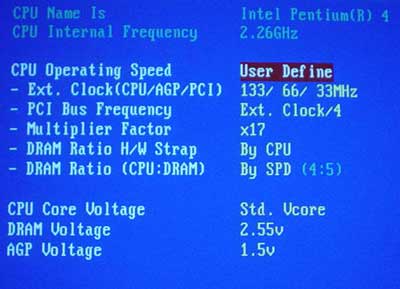
As per ABIT's recent tradition, there is a section in the BH7's BIOS dedicated to frequency and multiplier adjustment. You obviously won't be able to take advantage of the multiplier options available in this BIOS, but you will be able to take advantage of the frequency control options present, especially if you like to overclock. Some of features in this section include voltage adjustments like Vcore, VDIMM and VAGP, as well as FSB/AGP/PCI frequency tweaking and DRAM ratio adjustments (1:1 and 4:5). The FSB/AGP/PCI frequency options available obviously mean the BH7 employs an AGP/PCI lock no matter what the FSB frequency. The AGP/PCI lock is a godsend to FSB overclockers out there, and is slowly becoming standard among motherboard BIOSes, especially from nForce2 and the latest SiS motherboards.
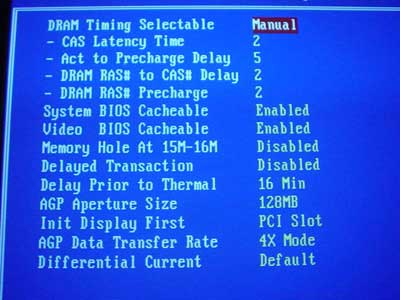
In the Advanced Chipset Features of the BH7 BIOS there are options for adjusting various memory timings such as Active to Precharge, Precharge to Active, Active to CMD and CAS latency. There are a few other minor DRAM timing options available, but nothing that will affect performance in any noticeable way. While this particular Advanced Chipset Features section is pretty standard among enthusiast motherboards, it pales in comparison to nForce2 BIOSes and recent retail KT400A BIOSes.
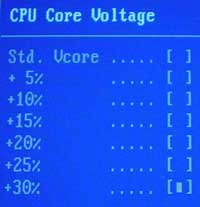
As we mentioned before, there are a good deal of voltage adjustments available in the Soft Menu III section. First is Vcore, which is adjustable up to 1.95V in 5% increments. This will most definitely satisfy the vast majority of overclockers, including the hardcore ones. Even though idle Vcore runs at about 1.46V, you'll be able to achieve 1.9V if you dare to do so with your Pentium 4 CPU. Even future Pentium 4 CPUs with default Vcore's of 1.55V should do just fine in an overclocking motherboard like the ABIT BH7.
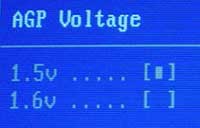 |
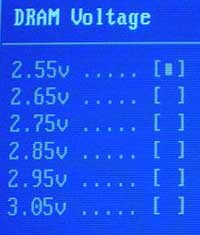 |
VDIMM options in the Soft Menu III section are also some of the most plentiful we've ever seen, competing well with high VDIMM BIOS options from the likes of Epox. In the BH7 BIOS we received, VDIMM was adjustable up to 3.05V in 0.1V increments starting from 2.55V. Actual VDIMM as read in the BIOS PC Health section fluctuated between 2.55 and 2.56V when VDIMM was set to default (2.55V) in the Soft Menu III section. This should delight memory overvolters, though there's usually very little use in going over 2.8V on your memory anyway. Speaking of overvolting, there are VAGP adjustments available up to 1.6V (1.5V is the default). You'll be getting 1.65V in actuality if you choose the 1.6V option in the Soft Menu III section, as idle VAGP runs at about 1.55V.
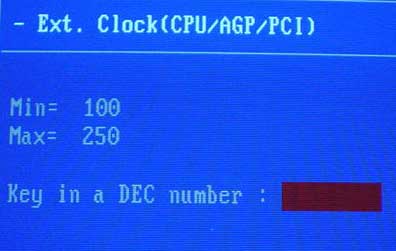
FSB frequencies of up to 250MHz can also be found in the Soft Menu III section of the BH7 BIOS. This should offer plenty of room for overclockers, even 800MHz FSB overclockers. Though obviously, the more adventurous overclockers that have 800MHz FSB CPUs will decide they want more than 250MHz FSB. We haven't heard of any current Intel motherboards being able to reach 250MHz FSB (1000MHz QDR FSB) anyway, so this may be of little consequence.
FSB Overclocking
|
Front Side Bus Overclocking Testbed |
|
|
Processor:
|
Mobile
Pentium 4 1.7GHz
|
|
CPU
Vcore:
|
1.50V
(actual)
|
|
Cooling:
|
Intel
Retail HSF & Thermal Pad
|
|
Power
Supply:
|
Enermax
300W
|
Normally we use a run-of-the-mill 2.26GHz B0 stepping (SL67Y) Pentium 4 processor for our overclocking tests. However with the ABIT BH7 we thought it necessary to find out if its supposed 800MHz FSB support was just marketing hype or reality. Therefore we used a mobile 1.7GHz Pentium 4 processor for our FSB overclocking tests. This is the same processor used in our 800MHz Sneak Peek article a couple weeks ago, and of course this CPU still has a default multiplier of 12 (instead of 17) when installed in a desktop motherboard like the ABIT BH7. Just to reiterate a point we made about the 1.7M CPU in the 800MHz FSB Sneak Peek article, the lower the multiplier the higher the FSB overclock, and since 12 is by far the lowest Pentium 4 multiplier in existence the 1.7M is the perfect CPU for 800MHz FSB testing (besides having an actual 800MHz FSB CPU of course).
We're happy to report that the ABIT BH7 can indeed reliably operate at 800MHz FSB. In fact, the BH7 was able to reach just over 218MHz FSB (that's about 872MHz FSB for those of you that are mathematically impaired :)). At 218MHz FSB, DRAM was running synchronously for an effective clock rate of 436MHz with timings set to CAS2/3T/6T/3T. This is very impressive to say the least. Of course no one is going to be able to overclock any current desktop Pentium 4 processor to 218MHz FSB; we're merely trying to demonstrate that the ABIT BH7 runs at and even well beyond its 800MHz FSB specifications by using a mobile CPU with a low multiplier.
For now, overclockers should be looking to purchase C1 stepping Pentium 4 processors, as these babies have proven themselves to be overclockable in the 170-180MHz FSB range on a good Pentium 4 motherboard. Just to clarify, the FSB overclocking results you've been reading about in past Pentium 4 motherboard reviews were all conducted using a B0 stepping Pentium 4 processor, which by itself is capable of no more than 160MHz-166MHz FSB, irregardless of the motherboard.
ABIT BH7: Stress Testing
We managed to test the ABIT BH7 in several different areas and configurations, including:
1. Chipset and motherboard stress testing was conducted by running the FSB at 218MHz.
2. Memory stress testing was conducted by running RAM at 333MHz and 400MHz at the most aggressive timings possible.
Front Side Bus Stress Test Results
At 218MHz FSB we did not encounter any reliability issues with the ABIT BH7 (at least issues that we could notice in the small timeframe we tested this motherboard). At this speed we were able to run 24 hours of Prime95 torture tests without a single failure. We reran our gaming suite (Unreal Tournament, Quake 3 Arena, Jedi Knight II) in addition to data compression and Word and Excel apps while those 24 hours of Prime95 torture tests were running in the background. We also found some time to run SPECviewperf and XMPEG to put even more stress on the BH7, but after all was said and done the BH7 came out a winner.
Memory Stress Test Results
Since all 845PE motherboards support the DDR333 standard, we obviously had to conduct some type of DDR333 memory testing. As usual, we decided to simply test the board in the most strenuous situation possible at DDR333 speeds, and that of course meant testing at the lowest timings with all DIMM slots occupied. Here were our first batch of results:
|
Stable
DDR333 Timings |
|
|
Clock
Speed:
|
166MHz
|
|
Timing
Mode:
|
N/A
|
|
CAS
Latency:
|
2
|
|
Bank
Interleave:
|
N/A
|
|
Precharge
to Active:
|
2T
|
|
Active
to Precharge:
|
5T
|
|
Active
to CMD:
|
2T
|
|
Command
Rate:
|
N/A
|
We're delighted that the ABIT BH7 is able to achieve these memory timings with all memory banks filled and running at 333MHz DDR. These DRAM timing results matches the results we experienced with the ABIT IT7 Max2 V.2, ABIT's cutting-edge 845PE motherboard. We look forward to testing ABIT's first dual DDR Pentium 4 motherboard, which will come once Intel releases their 865 and 875 chipsets in April and May.
DDR400 memory speeds should be more challenging for the ABIT BH7, as neither Intel nor ABIT has validated for DDR400 operation, especially when all memory banks are filled. Here were the best results we could achieve at 400MHz DDR:
|
Stable
DDR400 Timings |
|
|
Clock
Speed:
|
200MHz
|
|
Timing
Mode:
|
N/A
|
|
CAS
Latency:
|
2
|
|
Bank
Interleave:
|
N/A
|
|
Precharge
to Active:
|
2T
|
|
Active
to Precharge:
|
6T
|
|
Active
to CMD:
|
2T
|
|
Command
Rate:
|
N/A
|
These are actually the second best memory timing results we've been able to get with an 845PE motherboard, tied with the Albatron PX845PEV Pro and just a hair below the ASUS P4PE (active to precharge of 5T instead of 6T). This is impressive in case you didn't already catch the hint.
As usual, we ran several memory stress tests and general apps to make sure all these timings were stable. We started off by running Prime95 torture tests; a grand total of 24 hours of Prime95 was successfully run at the timings listed in the above charts. We also ran Sciencemark (memory tests only) and Super Pi. After all was said and done, the ABIT BH7 was able to withstand each of these memory stress tests.
ABIT BH7: Tech Support and RMA
For your reference, we will repost our support evaluation procedure here:
The way our Tech Support evaluation works is first we anonymously email the manufacturer's tech support address(es), obviously not using our AnandTech mail server to avoid any sort of preferential treatment. Our emails (we can and will send more than one just to make sure we're not getting the staff on an "off" day) all contain fixable problems that we've had with our motherboard. We then give the manufacturer up to 72 hours to respond over business days and will report not only whether they even responded within the time allotted but also if they were successful in fixing our problems. If we do eventually receive a response after the review is published, we will go back and amend the review with the total time it took for the manufacturer to respond to our requests.
The idea here is to encourage manufacturers to improve their technical support as well as provide new criteria to base your motherboard purchasing decisions upon; with motherboards looking more and more alike every day, we have to help separate the boys from the men in as many ways as possible. As usual, we're interested in your feedback on this and other parts of our reviews so please do email us with your comments.
ABIT's RMA policy hasn't changed since the last time we
took a look at it. Information regarding ABIT's U.S. RMA policy, dubbed
eRMA (Express RMA), can be found here.
ABIT's eRMA guarantees two critical things that most other motherboard makers are too shy or unwilling to make:
1. ABIT clearly explains that they will accept and process direct RMAs.
2. ABIT guarantees a 10-day turnaround policy on all RMAed motherboards.
ABIT's RMA and warranty information are also easily accessible on their U.S. web site by simply clicking the eRMA hyperlink at the left-hand corner of the page and cycling through each category. All in all, ABIT continues to do a great job making their RMA and warranty information easily available and understandable on their web site, which is a huge advantage over other top tier motherboard manufacturers.
ABIT's tech support isn't as impressive as far as available information on their web site. However, there is an email address you can use if you need to write to tech support, which is [email protected]. You can also reach ABIT in the U.S. by phone at (510) 492-0968 as well. Their hours are pretty good too; 9:00am to 6:00pm (although ABIT's phone hours are a bit better in the U.S.).
As far as email tech support response time was concerned, ABIT did very well this time around, clocking in at 26 hours. Yet again, tech support was friendly and very helpful in general, and they answered our question with great accuracy.
We'd like to reiterate that ABIT's RMA policy is unmatched in the U.S.; no other motherboard manufacturer comes close. In combination with their timely tech support reply we feel ABIT is one of the best (if not the best) motherboard manufacturer to turn to for motherboard customer service and support in the U.S. We're glad ABIT continues to work hard on this aspect of their operations, and hope to see similar steps taken at other top tier motherboard manufacturers.
The Test
|
Performance Test Configuration |
||
| Processor(s): |
Intel
Pentium 4 2.26GHz
|
|
| RAM: |
2 x 256MB Corsair PC3200 TwinX Modules
1 x 512MB Corsair PC3200 XMS Module |
|
| Hard Drive(s): |
Western Digital 120GB 7200 RPM
Special Edition (8MB Buffer)
|
|
| Bus Master Drivers: |
Intel INF Update v4.04.1012
Intel Application Accelerator v2.3 SiS AGP v1.13 |
|
| Video Card(s): |
ASUS
V8460 Ultra NVIDIA GeForce4 Ti 4600
|
|
| Video Drivers: |
NVIDIA
Detonator 41.09
|
|
| Operation System(s): |
Windows
XP Professional SP1
|
|
| Motherboard(s): |
ABIT
BH7 (845PE)
ABIT IT7 MAX2 Rev 2 (845PE) ASUS P4G8X Deluxe (E7205) ASUS P4T533-C (850E) MSI 655 Max (SiS 655) |
|
The AnandTech Motherboard Testbed was Sponsored by Newegg. You can buy the components we used to test at www.newegg.com.
All performance tests run on the SiS 655-based MSI 655 Max motherboard utilized two 256MB Corsair TwinX PC3200 modules set to a CAS 2.5 timing (in Ultra Fast Command) running in dual channel DDR400 mode. Any other performance-enhancing timings (like Command Rate or Bank Interleave) were enabled in SiS 655-based motherboards that contained such timings.
All performance tests run on E7205-based motherboards utilized two 256MB Corsair TwinX PC3200 modules set to CAS 2/2T/5T/2T timings and running at 266MHz (dual channel). Any other performance-enhancing timings (like Command Rate or Bank Interleave) were enabled in E7205-based motherboards that contained such timings.
All performance tests run on 845PE motherboards utilized one 512MB Corsair XMS PC3200 module set to CAS 2/2T/5T/2T timings and running at 333MHz. Any other performance-enhancing timings (like Command Rate or Bank Interleave) were enabled in motherboards that contained such timings.
Content Creation & General Usage Performance
For our Content Creation & General Usage performance we continue to use SYSMark 2002. The applications benchmarked include:
· Internet Content Generation: Adobe Photoshop® 6.01, Adobe Premiere® 6.0, Microsoft Windows Media Encoder 7.1, Macromedia Dreamweaver 4, and Macromedia Flash 5
· Office Productivity: Microsoft Word 2002, Microsoft Excel 2002, Microsoft PowerPoint 2002, Microsoft Outlook 2002, Microsoft Access 2002, Netscape Communicator® 6.0, Dragon NaturallySpeaking Preferred v.5, WinZip 8.0, and McAfee VirusScan 5.13.
For more information on the methodology and exactly what SYSMark does to generate these performance scores check out BAPCo's SYSMark 2002 Whitepaper.
|
|
Video Encoding Performance
|
Gaming Performance
|
|
Gaming Performance (continued...)
|
|
High End Workstation Performance - SPEC Viewperf 7.0
The latest version of SPEC Viewperf proves to be an excellent stress test for memory bandwidth and overall platform performance as you're about to see. The benchmarks included version 7 of the benchmark suite are:
3ds max (3dsmax-01)
Unigraphics (ugs-01)
Pro/Engineer (proe-01)
DesignReview (drv-08)
Data Explorer (dx-07)
Lightscape (light-05)
For more information on the tests run visit SPEC's page on the new Viewperf benchmark.
|
|
|
High-End Workstation Performance (continued...)
|
|
|
Final Words
After thoroughly testing the ABIT BH7, it's quite clear that it's one of the best 845PE motherboards we've ever tested. As a low cost, high-performance motherboard the ABIT BH7 is definitely one of the top two 845PE motherboards to purchase, accompanying Albatron's PX845PEV Pro motherboard released in October of last year.
All in all the ABIT BH7 is the most overclocker-friendly desktop Pentium 4 motherboard we've ever come across, rivaling Epox, ASUS and Albatron motherboards of all chipsets and varieties. Overclocking most certainly isn't the BH7's only strength, as its combination of USB 2.0, Serial ATA, LAN, sound, and rear SPDIF ports among other onboard features makes it a steal considering it's currently selling for anywhere between $90-100 in the U.S. Combine the BH7's overclocking ability, features, and price with the best RMA and tech support combination we've seen in the U.S. and you have your perfect desktop motherboard.
This is all despite the fact that 865 and 875 motherboards are coming, as their presence in the retail channel won't really be felt for weeks, and even then they will never reach the price point ABIT is able to hit with the BH7, mostly due to the BH7's 845PE/ICH4 costs versus what motherboards with 865/875/ICH5 chipsets will run for.
Speaking of Intel's 865 and 875 chipsets, stay tuned for upcoming technology and motherboard reviews on these chipsets, in addition to coverage of SiS 648FX and 655FX.

